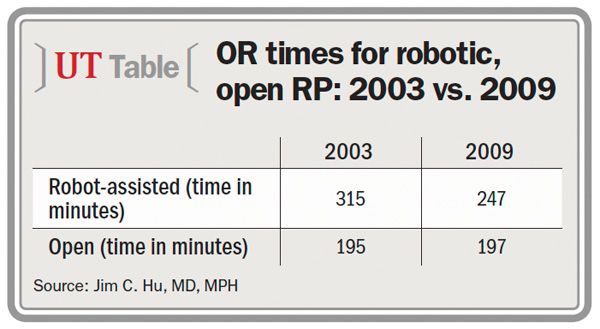Article
Higher surgeon volume linked to lower RALP costs
A study from the UCLA Ronald Reagan Medical Center appears to once again prove that time is money. The study’s findings indicate that up to $15 million could be saved annually by referring patients who are candidates for robot-assisted radical prostatectomy to surgeons and surgical centers with optimal operating times.
New Orleans-A study from the UCLA Ronald Reagan Medical Center appears to once again prove that time is money. The study’s findings indicate that up to $15 million could be saved annually by referring patients who are candidates for robot-assisted radical prostatectomy (RALP) to surgeons and surgical centers with optimal operating times.

Dr. Hu“There are big (operating time) differences between less experienced surgeons and those with more experience-as much as 42 minutes. On average, 1 minute of operating time costs about $15. That is more than $600 in savings generated by high-volume surgeons (per procedure) over low-volume surgeons,” senior author Jim C. Hu, MD, MPH, director of minimally invasive and robotic surgery in UCLA’s department of urology, told Urology Times.
The study was presented at the 2013 World Congress of Endourology and SWL in New Orleans and published online in BJU International (Sept. 9, 2013).
The reduced OR times achieved by high-volume surgeons have clinical implications, especially for patients with comorbid disease, older patients, and obese patients. Longer radical prostatectomy OR time subjects men to longer general anesthesia, which raises risks of fluid overload, infection, slower recovery, and other complications not necessarily associated with the primary procedure.
Another significant finding was that operating times for RALP have been dropping sharply for a number of years, a trend that apparently has yet to plateau. From 2003 through 2009, operating times have fallen from 315 minutes to 247 minutes, a decline of 68 minutes or 22%, whereas times for the retropubic radical prostatectomy remained steady: 195 versus 197 minutes.
Dr. Hu said the steadily improving RALP times represented a diffusion of the procedure and its associated technologies.
“The robot procedure came out in 2001, and until 2004, only a small proportion of prostatectomies were being done robotically. But by 2008-2009, the years spanned by this population-based study, nearly half of prostatectomies were being done robotically. The changing OR times show that there was a lot of room for improvement. The open procedure was popularized by Dr. Patrick Walsh with his description of nerve-sparing in 1982. Those times changed very little during our study period,” Dr. Hu told Urology Times.
He added that despite the declining OR times, he and his colleagues found that the robotic procedure still took about 17 minutes longer on average than the open procedure.
Continue to next page for more.
OR times vary by practice size, location
There were other notable differences discovered by the authors. Operating times varied by organizational status, with group practices achieving faster OR times than solo and two-physician practices. Geographic regions differed, with the South posting faster times compared to the Northeast and Midwest.

“I think the geographic differences we see in terms of operative times relates to the observation that there is now a greater diffusion of the robotic modality compared to competing treatments such as radiation therapy and other treatments. At least that is my hypothesis,” said Dr. Hu.
For the study, Dr. Hu and colleagues gathered information from the U.S. Surveillance, Epidemiology, and End Results (SEER) and Medicare-linked database for men diagnosed with prostate cancer between 2002 and 2007, and who underwent robotic or open radical prostatectomy through 2009. They acquired data on 3,458 robotic procedures and 6,993 retropubic surgeries. They identified median operative times using anesthesia administrative data and used regression analysis to evaluate the impact of surgeon experience, group, region, and a number of other factors.
“The advantage of a study such as this one is that you are not looking at a single institution’s outcomes but what is going on in the community as a whole,” said Dr. Hu.
“Robot operating times remain a moving target, whereas the open procedure has not changed. The primary observation is that there are tremendous differences in the operative times of surgeons across the U.S. and that this presents opportunities to decrease these variations in care.”UT
Like this article? Check out these other recent Urology Times articles:
Primary ADT for prostate cancer shows no survival benefit
Application for pre-chemo use of prostate cancer agent submitted
Drop in PSA screening greatest among urologists
Subscribe to Urology Times to get monthly news from the leading news source for urologists.



